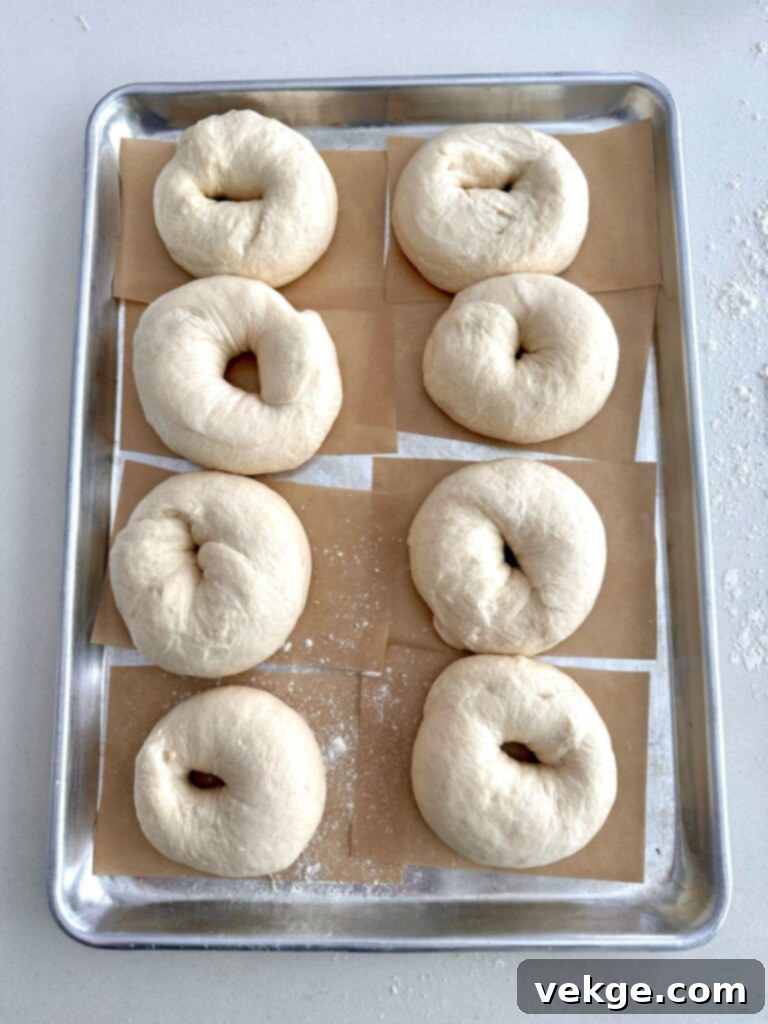Unlock the secret to bakery-quality bagels right in your own kitchen with this incredible sourdough bagel recipe! Few ingredients are needed to create these ultra-chewy, gloriously delicious, and deeply satisfying bagels. While traditional bagels are certainly good, sourdough bagels elevate the experience to an entirely new level. They boast a wonderfully soft interior contrasted with that perfect, characteristic chewy bite, making them absolutely irresistible when enjoyed fresh out of the oven.
There’s an undeniable magic that comes with homemade bread, and bagels are no exception. The process of crafting them from scratch, combined with the unique flavors of sourdough, makes for a truly rewarding baking adventure and a superior end product. You’ll not only taste the difference but also appreciate the wholesome ingredients and effort you’ve poured into every single bite.

Crafting the Perfect Sourdough Bagel: Essential Ingredients
One of the greatest joys of baking at home is having complete control over the ingredients that nourish your body. Unlike many store-bought options that often contain preservatives and artificial additives, this homemade sourdough bagel recipe embraces simplicity and natural goodness. By harnessing the power of a sourdough starter instead of commercial yeast, you’re not just creating delicious food, but also incorporating beneficial probiotics that support a healthy gut microbiome. Each ingredient plays a crucial role in achieving the signature texture and flavor of these artisanal bagels.
The Heart of Your Bagels: Active Bubbly Sourdough Starter
The foundation of truly exceptional sourdough bagels begins with an energetic and well-fed sourdough starter. For optimal results, your starter should be vibrant, bubbly, and active, ideally fed 4-12 hours before you plan to mix your dough. If your starter appears thin, sluggish, or hasn’t shown significant activity after feeding, it’s a sign it needs a little more attention before it’s ready for baking. A weak starter can lead to an under-proofed dough, resulting in dense, heavy bagels. For a comprehensive guide on cultivating and maintaining a robust starter, be sure to check out my Sourdough 101 Post, which covers everything you need to know about caring for your starter and successfully baking with it.
Sweetness with Purpose: Brown Sugar
A touch of brown sugar in the dough doesn’t just add a subtle depth of flavor; it also serves a vital purpose in the fermentation process. The natural sugars in brown sugar provide a readily available food source for your sourdough starter, encouraging robust activity and a quicker, more effective rise. Furthermore, it contributes to the beautiful golden-brown crust and complex notes in the final bagel without making them taste overly sweet. It’s a key element for both taste and texture development.
The Unsung Hero: Salt
Perhaps the most critical ingredient in any bread recipe, including bagels, is salt. Far from just seasoning, salt is indispensable for enhancing flavor, controlling fermentation, and strengthening the gluten structure in your dough. Forgetting the salt, or not adding enough, will inevitably lead to bland, disappointing results—trust me, I speak from experience! Properly salted dough yields a more balanced flavor profile and a superior texture.
I personally swear by Redmond fine sea salt for all my baking endeavors. Mined from an ancient seabed, it’s completely free of additives and boasts a rich array of naturally occurring trace minerals, which not only contributes to better flavor but also offers added nutritional benefits. If you’re looking to elevate your baking, give it a try. Use my exclusive code “AMBERSKITCHEN” to receive 15% off your entire order.
Building Blocks of Texture: Flour
For all my bread recipes, I consistently rely on bread flour. The higher protein and gluten content in bread flour are what give baked goods that desirable chewy texture and robust structure. This is especially true for bagels, where chewiness is a defining characteristic. If you have bread flour, it’s definitely the preferred choice for this recipe. However, if all-purpose flour is all you have on hand, it will still work, though your bagels might be slightly less chewy. For an even heartier bagel, you can experiment with substituting a portion of the bread flour with whole wheat flour, adjusting water content as needed to achieve the right dough consistency.

Step-by-Step Guide: How to Master Sourdough Bagels
Embarking on the journey of making sourdough bagels might seem intimidating at first, but it’s a surprisingly straightforward process that requires patience more than intensive effort. While sourdough baking does involve longer fermentation times compared to conventional yeast recipes, much of this time is hands-off, dedicated to allowing the dough to rise and develop flavor. By following these clear directions, you’ll be well on your way to creating professional-quality bagels in your own kitchen.
The Foundation: Make the Dough
Begin by combining all your ingredients – water, active sourdough starter, brown sugar, salt, and flour – in a large mixing bowl. Whether you use a stand mixer with a dough hook, a Bosch mixer, or prefer the tactile experience of kneading by hand, the goal is to work the mixture until it transforms into a smooth, elastic dough. This kneading process is crucial for developing the gluten structure, which in turn gives your bagels their characteristic chew. Aim for a dough that is firm but pliable, not sticky.
The First Rest: Bulk Fermentation (First Rise)
Once your dough is beautifully kneaded, place it in a lightly oiled bowl, cover it tightly with plastic wrap or a damp kitchen towel, and allow it to undergo its first rise, also known as bulk fermentation. This crucial step allows the sourdough starter to work its magic, fermenting the sugars and developing complex flavors. The time required for the dough to double in size can vary significantly, typically ranging from 5 to 10 hours, depending on factors like the ambient temperature of your kitchen and the vitality of your sourdough starter. Warmer environments accelerate the process, while cooler temperatures slow it down. Keep an eye on your dough throughout the day; it’s ready when it looks significantly larger and feels airy. For added convenience and a deeper flavor profile, you also have the option to cold proof your dough by placing it in the refrigerator for one to two days after a shorter initial rise at room temperature.

Shaping the Bagels
After your dough has successfully doubled in size, gently turn it out onto a lightly floured surface. Divide the dough into 8 equal portions. For consistent results, a kitchen scale can be very helpful here. To shape each bagel, roll a portion of dough into a snake-like rope, roughly 8-10 inches long. Then, bring the ends together to form a circle, overlapping them slightly, and firmly pinch the edges to create a seamless, smooth bagel shape. Ensuring a tight seal prevents the bagels from unraveling during boiling.
Prepare 8 individual squares of parchment paper. Place each newly shaped bagel onto its own parchment square. These parchment squares are essential as they will prevent the delicate shaped bagels from sticking to your work surface and help maintain their perfect form when you transfer them to the boiling water later. Once all bagels are shaped and on their parchment squares, cover them loosely and let them rise again until they have nearly doubled in size. This second rise, or proofing, is vital for a light, airy crumb.

The Crucial Boil
Boiling is a non-negotiable step that gives bagels their signature chewy exterior and glossy crust. Bring a large pot of water to a rolling boil. To enhance the flavor and promote a beautiful brown crust, add 2 tablespoons of baking soda and ¼ cup of honey to the boiling water. The baking soda increases the alkalinity of the water, which helps with the Maillard reaction during baking, leading to that distinctive rich color and flavor. The honey adds a subtle sweetness and further aids browning.
Carefully lower the shaped bagel dough, still attached to its parchment paper square, into the simmering water. As the parchment paper becomes wet, it will naturally loosen from the dough, allowing you to easily peel it off and set it aside for future use or discard. Boil each bagel for approximately 45 seconds per side. This quick bath par-cooks the exterior, setting the crust and contributing to the dense, chewy texture. Once boiled, gently remove the bagels with a slotted spoon and place them onto a prepared baking sheet.

Before baking, brush each bagel with an egg wash (typically one egg beaten with a tablespoon of water or milk) to promote a golden shine and help toppings adhere. This is the perfect moment to personalize your bagels with your favorite toppings! Our personal favorites are savory jalapeño and cheese bagels, offering a delightful kick. For those with a sweet tooth, cinnamon sugar is a fantastic choice. A pro tip for cinnamon sugar bagels: instead of an egg wash, brush them with melted butter before sprinkling the cinnamon sugar for a richer flavor and better adherence.

The Grand Finale: Bake
Preheat your oven to 425°F (220°C). Arrange your topped bagels on a baking sheet, ensuring there’s enough space between them for even cooking. Bake for approximately 20 minutes, or until they achieve a beautiful golden-brown color and sound hollow when tapped on the bottom. The high oven temperature helps to create a crispy crust while ensuring the interior is fully cooked and chewy. Serve your homemade sourdough bagels immediately to enjoy them at their peak of freshness. They are utterly divine simply split and slathered with butter or a generous dollop of cream cheese. These versatile bagels also make an incredible foundation for hearty breakfast sandwiches, piled high with your favorite fillings.

Elevate Your Bagels: Creative Topping Ideas
The beauty of homemade bagels lies in the endless possibilities for customization. Don’t limit yourself to just one topping; feel free to experiment and find your perfect combination! While we adore the spicy and savory combination of jalapeño and cheddar, here are some other fantastic topping ideas to inspire your sourdough bagel creations:
- Everything Bagel Seasoning: A classic for a reason, offering a delightful mix of savory and aromatic flavors.
- Sesame Seeds: Adds a nutty flavor and satisfying crunch.
- Poppy Seeds: Another traditional choice, providing a delicate, earthy note.
- Any Type of Cheese: Beyond cheddar, consider mozzarella, Parmesan, or a blend of Italian cheeses for a gourmet touch.
- Cinnamon Sugar: Perfect for a sweet treat, especially when brushed with butter beforehand.
- Dried Onion or Garlic Flakes: For an extra layer of savory depth.
- Coarse Sea Salt: A simple yet effective way to highlight the bagel’s flavor and texture.
Why Choose Sourdough Bagels? The Benefits Beyond Taste
Beyond their incredible flavor and satisfying chew, sourdough bagels offer several advantages that make them a standout choice for health-conscious eaters and culinary enthusiasts alike:
- Enhanced Digestibility: The long fermentation process of sourdough helps break down complex carbohydrates and gluten, making the bagels easier to digest for many people compared to those made with commercial yeast.
- Improved Nutrient Absorption: Sourdough fermentation increases the bioavailability of certain vitamins and minerals, meaning your body can absorb them more effectively.
- Gut Health Benefits: Active sourdough starters contain beneficial bacteria and yeasts that contribute to a healthy gut microbiome, which is linked to overall well-being.
- Unique Flavor Profile: Sourdough imparts a distinct tanginess and depth of flavor that can’t be replicated by conventional yeast, adding a gourmet touch to your breakfast or snack.
- Extended Freshness: The natural acids produced during sourdough fermentation act as a natural preservative, keeping your bagels fresh for longer without artificial additives.
- Sense of Accomplishment: There’s immense satisfaction in creating something so delicious and wholesome from scratch, using a living ingredient like sourdough starter.
Tips for Sourdough Bagel Success
- Maintain an Active Starter: This is paramount. A weak starter will lead to a dense, flat bagel. Ensure it’s bubbly and active before you begin.
- Don’t Rush the Rise: Sourdough takes time. Be patient with the bulk fermentation and second rise. Temperature plays a big role; a slightly warmer spot can help, but avoid anything too hot.
- Proper Kneading: Develop the gluten sufficiently for that signature chew. If kneading by hand, aim for 10-15 minutes until the dough is smooth and elastic.
- Gentle Handling: Sourdough dough can be delicate, especially after its final proof. Handle the shaped bagels gently when transferring them to the boil.
- Boiling is Key: Never skip the boil! It’s what sets the crust and creates the chewy interior. Don’t over-boil, as this can make them too dense.
- Storage: Once cooled, store bagels in an airtight container at room temperature for up to 2-3 days, or slice and freeze them for longer storage. Toast from frozen for a quick treat.
Frequently Asked Questions About Sourdough Bagels
Can I use sourdough discard for this recipe?
While some recipes use discard for flavor, for sourdough bagels that need to rise significantly, an active, fed, bubbly starter is essential. Discard won’t have the leavening power needed for the proper texture.
How long do homemade sourdough bagels stay fresh?
Homemade sourdough bagels are best enjoyed on the day they are baked. They will remain fresh in an airtight container at room temperature for up to 2-3 days. Beyond that, they are excellent toasted.
Can I freeze sourdough bagels?
Absolutely! Sourdough bagels freeze beautifully. Once they have completely cooled, you can slice them first (if desired) and then place them in an airtight freezer bag. They will keep well for up to 3 months. When ready to eat, simply toast directly from frozen.
What if my dough isn’t rising?
This is usually due to a few factors: an inactive sourdough starter, a too-cold environment, or insufficient kneading. Double-check your starter’s activity, try placing your dough in a slightly warmer spot, and ensure you kneaded long enough to develop the gluten.
Why do I need to boil the bagels?
Boiling the bagels creates their signature chewy crust and gives them that distinct glossy appearance. The hot water gelatinizes the starches on the surface, which then sets during baking, contributing to the unique texture that defines a true bagel.
My Favorite Sourdough Bread Recipes
If you’ve enjoyed making these sourdough bagels, you might love exploring more sourdough adventures with these other fantastic recipes:
Sourdough Rosemary French Bread
Natural Yeast Sourdough Sandwich Bread
Sourdough Cinnamon Rolls

Happy Cooking and Baking!
I genuinely hope this comprehensive guide inspires you to bake and love this sourdough bagel recipe as much as I do. There’s nothing quite like the aroma of freshly baked bagels filling your home. If you want to continue following along on my culinary adventures, find more recipes, and share your own baking successes, be sure to follow me on Instagram @AMBERSKITCHEN.

Easy Sourdough Bagels
Print
Pin
Rate
25 minutes
20 minutes
8
bagels
Ingredients
- 1 cup active bubbly sourdough starter
- 1.5 cups warm water
- 1 Tablespoon brown sugar
- 2 teaspoons salt
- 3.5 to 4 cups flour (preferably bread flour)
- Toppings like cheese, sliced jalapeños, or cinnamon sugar
Instructions
- Combine water, sourdough starter, sugar, salt, and flour in a large mixing bowl. Mix and knead all ingredients together using a stand mixer or by hand until a smooth and elastic dough forms.
- Place the dough in a lightly oiled bowl, cover it, and let it rise until it has doubled in size. This bulk fermentation step typically takes 5-10 hours, depending on your kitchen’s ambient temperature and the strength of your starter. Alternatively, you can place the covered dough in the fridge for 1-2 days for a slower, colder rise that develops deeper flavor.
- Once doubled, gently turn the dough out onto a lightly floured surface.
- Divide the dough into 8 equal portions. Roll each portion into a snake about 8-10 inches long, then bring the ends together to form a circle. Firmly pinch the connecting sides together to create a smooth, sealed bagel shape.
- Cut out 8 individual squares of parchment paper and place one shaped bagel on each square. Cover the shaped bagels and let them rise again (proof) until they have doubled in size.
- Bring a large pot of water to a rolling boil. Add 2 tablespoons of baking soda and ¼ cup of honey to the boiling water.
- Carefully drop the bagel dough – parchment paper and all – into the boiling water. The parchment will loosen as it gets wet, allowing you to easily remove it from the pot. Boil each bagel for approximately 45 seconds per side.
- Using a slotted spoon, transfer the boiled bagel dough directly onto a baking sheet that is either greased or lined with parchment paper.
- Brush each bagel with an egg wash (one egg beaten with 1 tbsp water) and then apply your desired toppings. For cinnamon sugar bagels, I find that melted butter works best instead of egg wash for better adherence and flavor. We particularly love the savory jalapeño cheddar bagels!
- Bake in a preheated oven at 425°F (220°C) for about 20 minutes, or until golden brown. Remove from the oven and serve immediately! Enjoy your freshly baked sourdough bagels!
